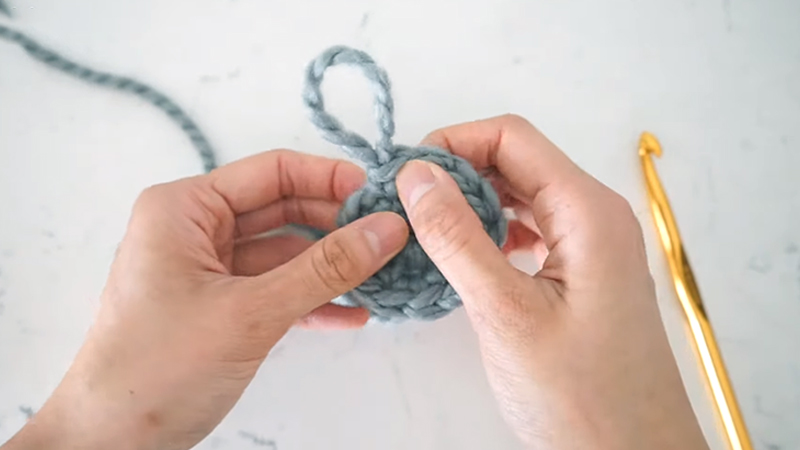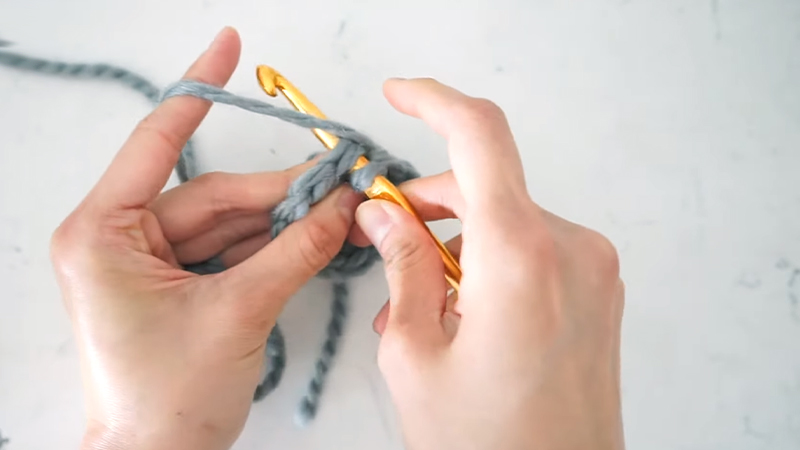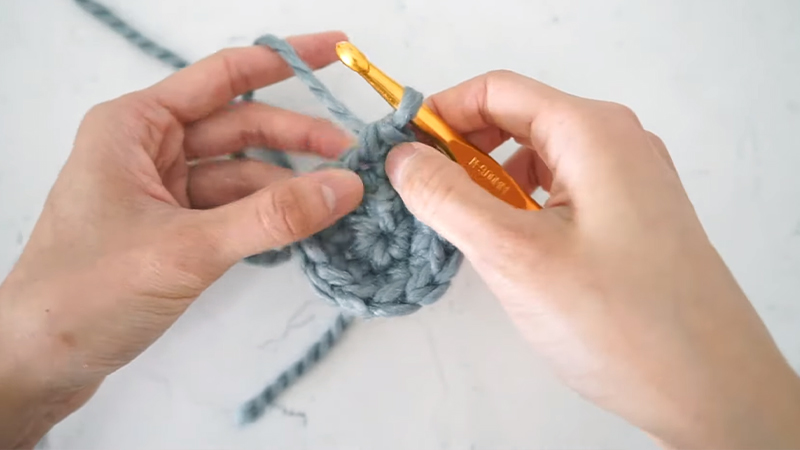Single crochet increase, often abbreviated as “sc inc,” is a fundamental technique in crochet that allows you to add stitches in a controlled manner.
This simple yet powerful skill is invaluable for shaping your projects, creating curves, angles, or gradual widening.
Whether you’re crafting amigurumi characters, fashioning hats, or designing intricate patterns, understanding how to execute a single crochet increase is essential.
In this guide, we’ll delve into the step-by-step process, providing detailed instructions and tips to ensure your increases are seamless and polished. With practice, you’ll unlock a whole new dimension of creativity in your crochet endeavors.

What Is a Single Crochet Increase?
A single crochet increase, abbreviated as “sc inc,” is a fundamental technique in crochet. It involves placing two single crochet stitches into the same stitch or space, effectively adding one extra stitch.
This technique is used to shape crochet projects, creating gradual widening or curves. It’s particularly essential in amigurumi, hats, and other items that require three-dimensional form.
To execute a single crochet increase, insert the hook into a stitch, yarn over, pull up a loop, yarn over again, and complete the first single crochet.
Without moving to the next stitch, reinsert the hook into the same stitch, yarn over, pull up a loop, yarn over again, and complete the second single crochet. This results in two stitches worked into one, expanding the project.
How to Single Crochet Increase?
Increasing in single crochet is a fundamental technique in crochet that allows you to add stitches to your work, creating a gradual widening or shaping. This technique is commonly used when making amigurumi, hats, and other crochet projects that require shaping.
Single crochet increase, often abbreviated as “sc inc,” involves adding two single crochet stitches into the same stitch or space.
Here’s a step-by-step guide on how to single crochet increase:
Materials Needed:
- Yarn of your choice
- Appropriate crochet hook for your yarn
- A project to work on (e.g., a swatch or a pattern)
Step-by-Step Instructions for Single Crochet Increase:
Start with a Foundation Chain
Begin by creating a foundation chain with your chosen yarn and crochet hook. The number of chains you make will depend on your specific pattern or design.
Ensure that your chain is not too tight, as it can make subsequent stitches more challenging.
Insert Hook into Stitch
When you’re ready to begin crocheting, insert your hook into the stitch where you want to increase.
When you’re working in rounds, this could be the same stitch you just completed. For rows, it’ll be the next stitch in the sequence.
Yarn Over (YO)
To start the single crochet increase, wrap the yarn from the back to the front over your hook. This action is known as a yarn over. It’s crucial for creating the loops needed to form the stitches.
Pull Up a Loop
Maintaining the yarn over on your hook, gently pull it through the stitch. This action will result in two loops on your hook.
Yarn Over Again
Performing another yarn over is crucial for setting up the next part of the stitch. This action creates the necessary loop on your hook to form the top of the next single crochet.
Complete the First Single Crochet (SC)
With two loops on your hook, carefully pull the yarn over through both loops. This motion finalizes the first single crochet in the increase. You should now have one completed stitch and two loops remaining on your hook.
Insert Hook into the Same Stitch
Without moving to the next stitch, reinsert your hook into the exact same stitch where you just made the first single crochet. This step allows you to work the second single crochet into the same location, effectively increasing the stitch count.
Yarn Over
Perform another yarn over. This prepares the hook to pull up a loop for the second single crochet in the increase.
Pull Up a Loop
Using the yarn over, gently pull up a loop through the same stitch. At this point, you should have three loops on your hook. This is one loop more than you had during the first single crochet.
Yarn Over Again
Perform one more yarn over. This prepares the hook for the final pull-through, creating the top of the second single crochet.
Complete the Second Single Crochet (SC)
With three loops on your hook, pull the yarn over through all three loops. This action finalizes the second single crochet in the increase. You now have two single crochet stitches in the same stitch.
Continue with Your Pattern
When your pattern specifies additional stitches, follow the instructions accordingly.
You might be instructed to make regular single crochets in the next stitches or perform another increase in a different stitch. Always pay close attention to the pattern to achieve the desired shape and size.
When Do You Use Single Crochet Increases?

Single crochet increases are employed in crochet projects where you need to widen or shape the work gradually.
Here are some common situations where you might use single crochet increases:
Amigurumi and Stuffed Toys
In amigurumi, single crochet increases are used extensively to create rounded shapes.
For instance, when making a teddy bear, you’d use increases to shape the head, body, arms, and legs. Without increases, the pieces would be flat and lack the desired 3D effect.
Hats
When starting at the crown of a hat, you typically begin with a small circle. As you work in the round, you’ll use single crochet increases to gradually widen the circumference.
This creates a seamless transition from the crown to the brim, resulting in a well-fitted hat.
Garments
In clothing projects, single crochet increases are employed to shape various components. For example, when making a sweater, you’ll use increases to shape the sleeves and achieve the desired fit around the neckline.
Circular and Oval Shapes
When aiming to crochet circles or ovals, single crochet increases are indispensable. They ensure that the work expands uniformly, resulting in a symmetrical shape. This technique is commonly used in doilies, coasters, and other circular items.
Rounded Edges
In projects like blankets or shawls, where rounded edges are desired, single crochet increases play a pivotal role. They enable you to smoothly curve around corners or along the edges, creating a polished and visually appealing finish.
Decrease and Increase Combos
Some advanced stitch patterns involve a combination of decreases and increases. By strategically placing these stitches, you can create intricate textures, such as shells, waves, or intricate lacework.
Adding Extra Details
Single crochet increases can be employed for decorative purposes. For instance, you might want to add extra stitches in a specific section of a pattern to create a raised texture or to emphasize a certain area of your project.
Adjusting Sizing
In patterns that require customization, single crochet increases offer a versatile tool. They allow you to adjust the size of a project to fit your preferences. Whether making a blanket, scarf, or garment, these increases help achieve the desired dimensions.
Troubleshooting When Using Single Crochet Increases

Using single crochet increases is a valuable skill, but like any crochet technique, it can sometimes present challenges.
Here are some common troubleshooting tips for when you encounter issues with single crochet increases:
Uneven Tension
- Issue: Uneven tension can lead to gaps or inconsistencies in your stitches, especially during increases.
- Solution: Practice maintaining consistent tension in your yarn. Focus on keeping the loops on your hook even in size.
Missed Stitches
- Issue: It’s easy to accidentally skip a stitch, especially when you’re working on a project with a high stitch count.
- Solution: Count your stitches regularly to ensure you haven’t missed any. Double-check your work after each increase to make sure you’ve placed two stitches in the correct stitch or space.
Adding Extra Stitches Unintentionally
- Issue: Sometimes, you might inadvertently add extra stitches due to misjudging the placement of the increase.
- Solution: Pay close attention to the pattern’s instructions for where to make the increases. Use stitch markers to mark the stitches where you intend to make your increases to help you stay on track.
Gaps Between Stitches
- Issue: Gaps can occur if you don’t pull the yarn through tightly enough or if your tension is too loose.
- Solution: Ensure that you pull the yarn through each loop firmly, but not so tightly that it distorts the stitches. Practice maintaining even tension throughout your work.
Difficulty Identifying Stitch Placement
- Issue: It can be challenging to identify the correct stitch, especially if you’re working with a dark or textured yarn.
- Solution: Use good lighting and consider working in a well-lit area. Take your time to locate the correct stitch before making your increases.
Incorrect Hook Size:
- Issue: Using the wrong hook size for your yarn can affect the tension and overall look of your stitches.
- Solution: Ensure that you’re using the correct hook size as recommended in your pattern. Experiment with different hook sizes if you’re still having trouble achieving the correct tension.
Not Following the Pattern Correctly
- Issue: Failing to follow the pattern’s specific instructions for increases can lead to errors.
- Solution: Carefully read and understand the pattern before you begin. Follow the increase instructions exactly as specified by the designer.
FAQS
Can I use single crochet increases in flat projects, or are they only for working in the round?
Single crochet increases can be used in both flat and round projects. In flat projects, you’ll typically increase at the beginning or end of a row to shape the piece.
How do I avoid gaps or holes when making single crochet increases?
To prevent gaps, make sure to maintain even tension while crocheting. Additionally, snugly pull the yarn over through the loops during each step to create a seamless increase.
Can I use a different type of stitch for increasing, or should I stick to single crochet?
While single crochet is the most common stitch for increasing, you can use other stitches like half double crochet or double crochet for different effects.
What happens if I accidentally skip the second part of the increase and only make one single crochet?
If you miss the second single crochet, you’ll end up with a regular single crochet instead of an increase. This may affect the overall shape of your project, so it’s important to double-check your work.
How do I incorporate single crochet increases into advanced stitch patterns or intricate designs?
In more complex patterns, the designer will provide specific instructions on where and how to make single crochet increases.
To Recap
Mastering the art of single crochet increase opens up a world of creative possibilities in crochet. This technique, while seemingly simple, holds the key to shaping and sculpting various projects.
From amigurumi toys with their endearing curves to well-fitted hats and intricately designed garments, the power of the single crochet increase is undeniable.
By following precise steps and troubleshooting any hiccups along the way, crocheters can confidently elevate their creations.
Remember, practice and patience are your greatest allies. So, embrace the process, let your creativity flow, and watch as each single crochet increase brings your projects to life, stitch by stitch.
Leave a Reply